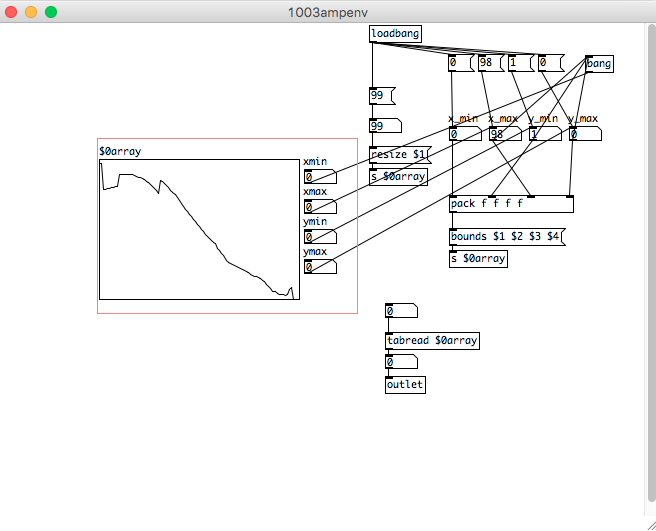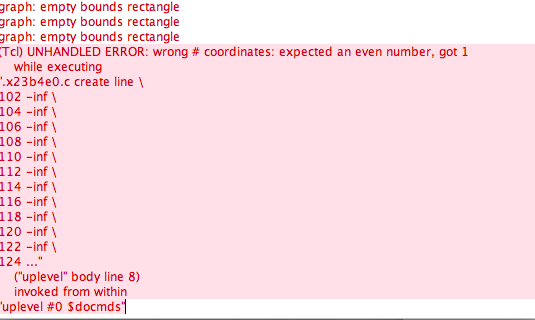-
Hasselbalch
posted in I/O hardware diy • read moreI opened up this thread on a complete whim, how lovely to see a response after so many months.
I tried out your code, alexandros - and it works just fine. I tried to add the rest of the pwm pins to the array and it worked just fine.
Can you explain why the message needs to start with "print" to work?Also, I've found it can only take integers, so it will misread floating point numbers and read the decimal numbers as the PWM value.
Of course I can just pass whatever number box or slider through a [i] object beforehand, but just out of curiosity, how would one allow floating point numbers in that code example?Thank you.
-
Hasselbalch
posted in technical issues • read more[line~] seems to work just great. Thank you so much, weightless and, as always, whale-av.
-
Hasselbalch
posted in technical issues • read moreGreat, just what I need. I just played around with it, I seem to get some crashes with that, I haven't tested it enough to be more specific than that right now.
And the age old question: what's the best way to get a clickless amp envelope? Any sort of quick ramp sent to
[*~]will create clicks, no matter what. It needs to be a very, very slow ramp before the clicks are not a problem. -
Hasselbalch
posted in technical issues • read moreWonderful, thank you. I misunderstood the order of the variables for the bounds message. I guess I could simplify it with an
exprconditional.Is there a Pd equivalent to Max's
functionobject? Just a breakpoint editor capable of making smooth envelopes.
And is there a way to make avoid drawing outside of the array? When I draw, it will allow me to go beyond the bounds of the visible square. I just useclipto avoid it spitting out the values, but it would be nice to have it within the actual array window. -
Hasselbalch
posted in technical issues • read moreMaybe that's it. I'm not too well-versed in reading the verbose error messages.
Here is the patch. I can't say for certain, but it seems to be the "y max" numbox that causes the problem.#N canvas 0 22 450 300 10; #N canvas 426 51 662 508 \$0ampenv 0; #N canvas 651 72 450 278 (subpatch) 0; #X array \$0array 99 float 1; #A 0 0.971429 0.971429 0.785714 0.785714 0.790476 0.795238 0.8 0.802857 0.805714 0.808571 0.892857 0.892857 0.892857 0.892857 0.892857 0.892857 0.892857 0.886905 0.880952 0.875 0.869048 0.863096 0.857143 0.844643 0.832143 0.819644 0.807144 0.791072 0.775001 0.75893 0.849995 0.842852 0.828567 0.814281 0.79821 0.782139 0.766068 0.749996 0.728568 0.70714 0.685711 0.666069 0.646426 0.626783 0.607141 0.589998 0.572855 0.555713 0.53857 0.521427 0.50357 0.485713 0.467856 0.449999 0.435714 0.421428 0.407143 0.4 0.364292 0.350007 0.328578 0.314293 0.278579 0.264293 0.25715 0.250008 0.242865 0.235722 0.228579 0.221436 0.214294 0.207151 0.200008 0.192865 0.17858 0.171437 0.164294 0.160723 0.157151 0.150009 0.135723 0.12858 0.107152 0.0928664 0.0785808 0.0571525 0.0571525 0.0428669 0.0357241 0.0357241 0.0357241 0.0285813 0.0357241 0.071438 0.0857236 0 0 0 0; #X coords 0 1 98 0 200 140 2 0 0; #X restore 102 121 graph; #X floatatom 388 265 5 0 0 0 - - -, f 5; #X obj 388 294 tabread \$0array; #X msg 372 108 resize \$1; #X obj 372 130 s \$0array; #X floatatom 372 80 5 0 0 0 - - -, f 5; #X obj 372 -13 loadbang; #X msg 372 49 99; #X msg 452 190 bounds \$1 \$2 \$3 \$4; #X floatatom 452 88 5 0 0 2 x_min - -, f 5; #X floatatom 492 88 5 0 0 2 x_max - -, f 5; #X floatatom 532 88 5 0 0 2 y_min - -, f 5; #X floatatom 572 88 5 0 0 2 y_max - -, f 5; #X obj 452 157 pack f f f f, f 20; #X obj 452 212 s \$0array; #X msg 451 16 0; #X msg 481 16 98; #X msg 511 16 1; #X msg 541 16 0; #X obj 388 338 outlet; #X floatatom 307 131 5 0 0 2 xmin - -, f 5; #X floatatom 307 161 5 0 0 2 xmax - -, f 5; #X floatatom 307 191 5 0 0 2 ymin - -, f 5; #X floatatom 307 221 5 0 0 2 ymax - -, f 5; #X floatatom 388 316 5 0 0 0 - - -, f 5; #X obj 588 17 bang; #X connect 1 0 2 0; #X connect 2 0 24 0; #X connect 3 0 4 0; #X connect 5 0 3 0; #X connect 6 0 7 0; #X connect 6 0 15 0; #X connect 6 0 16 0; #X connect 6 0 17 0; #X connect 6 0 18 0; #X connect 7 0 5 0; #X connect 8 0 14 0; #X connect 9 0 13 0; #X connect 10 0 13 2; #X connect 10 0 25 0; #X connect 11 0 13 1; #X connect 11 0 25 0; #X connect 12 0 13 3; #X connect 12 0 25 0; #X connect 13 0 8 0; #X connect 15 0 9 0; #X connect 16 0 10 0; #X connect 17 0 11 0; #X connect 18 0 12 0; #X connect 20 0 9 0; #X connect 21 0 10 0; #X connect 22 0 11 0; #X connect 23 0 12 0; #X connect 24 0 19 0; #X connect 25 0 9 0; #X coords 0 -1 1 1 260 175 2 100 100; #X restore 31 32 pd \$0ampenv; -
Hasselbalch
posted in technical issues • read moreHello. I'm messing about with creating envelope generators in Pd using arrays.
I've tried to make the array's settings easily changeable to allow it to work for amplitude, pitches and other uses, using variables sent to a message for the array.
But I've found that most of the time with this setup I just patched up I will, with a lack of better words, break Pd, get a bunch of error messages in the terminal and number boxes will stop showing changes, alongside dragging in values on the array.The patch in questions and the error message is shown here:


The values shown in the picture work fine, those are set up as an amp envelope. Changing certain parameters will break it, I can't quite be sure which. Sometimes I will just get the "graph: empty bounds rectangle" message, which will usually be followed by the more verbose error message.
The changes seem to be made, but it just won't show it. I have to completely quit Pd and open it again for it to return to normal.
As soon as the error message occurs, the number boxes will freeze and add "..." to the end, as if the number shown exceeds the width of the box, which is not the case.
I assume I'm running Pd into a wall, placing values that are out of bounds for the given array, but I can't tell how and why. It's my first venture into using graphical envelopes, I've usually just used the more primitive version of line ramps and delayed signals to get regular adsr envelopes.
Can anyone tell me what I might be doing wrong here?
I'm running vanilla 0.47.1 on a Macbook Pro running El Capitan.
Thank you.
-
Hasselbalch
posted in technical issues • read more@whale-av, ah. Thank you. The [echo message] prefix seem to give a readout with [print STDOUT] in Pd's own log/terminal, but nothing happens in osx terminal. Nothing is printed in there nor is it executed.
The format I need to use for the app, cliclick is [cliclick c:x,y] which will execute a button press on a specific point. But a comma seems to divide the messages sent to [shell] as it prints out [shell: old process still running]. So if [shell] interprets a comma as a command divisor, I might not be able to use without a workaround.
I read through the second thread as well, but I couldn't really find the answer. I might be way in over my head with this.
-
Hasselbalch
posted in technical issues • read more@youaresound, I tried that, but with no result. And [system] has got no outlet for me to print out any possible error messages.
If anyone has successfully used [shell] to send commands to the osx terminal, I'd like to hear how.
-
Hasselbalch
posted in technical issues • read moreThat seems to work as well, thanks.
Is there a simple way to send commands to the osx terminal using the [shell] object? I can't get it to pass anything usable through [shell], I can't figure out if I have to use a certain prefix or not.
All the examples I've found online are to do with specifying a directory, moving or creating files - all I want to do is pass a command as if I had typed into the terminal window itself. -
Hasselbalch
posted in technical issues • read moreThanks, @macrogmittrei.
I checked to see what I could do about using xdotool with Mac, and found another shell app, Cliclick (https://www.bluem.net/en/projects/cliclick/). It seems fairly simple and I can get it to click at specific points.
I have never used [shell] before and I'm not well-versed in shell/terminal use, so I'll have to see what I can do. The help documentation for [shell] is not a lot, but I suppose it assumes I know what I'm doing.
I just need to get pd to send some single lines of text to the terminal.
